Qing-Long Han
MS-Occ: Multi-Stage LiDAR-Camera Fusion for 3D Semantic Occupancy Prediction
Apr 22, 2025Abstract:Accurate 3D semantic occupancy perception is essential for autonomous driving in complex environments with diverse and irregular objects. While vision-centric methods suffer from geometric inaccuracies, LiDAR-based approaches often lack rich semantic information. To address these limitations, MS-Occ, a novel multi-stage LiDAR-camera fusion framework which includes middle-stage fusion and late-stage fusion, is proposed, integrating LiDAR's geometric fidelity with camera-based semantic richness via hierarchical cross-modal fusion. The framework introduces innovations at two critical stages: (1) In the middle-stage feature fusion, the Gaussian-Geo module leverages Gaussian kernel rendering on sparse LiDAR depth maps to enhance 2D image features with dense geometric priors, and the Semantic-Aware module enriches LiDAR voxels with semantic context via deformable cross-attention; (2) In the late-stage voxel fusion, the Adaptive Fusion (AF) module dynamically balances voxel features across modalities, while the High Classification Confidence Voxel Fusion (HCCVF) module resolves semantic inconsistencies using self-attention-based refinement. Experiments on the nuScenes-OpenOccupancy benchmark show that MS-Occ achieves an Intersection over Union (IoU) of 32.1% and a mean IoU (mIoU) of 25.3%, surpassing the state-of-the-art by +0.7% IoU and +2.4% mIoU. Ablation studies further validate the contribution of each module, with substantial improvements in small-object perception, demonstrating the practical value of MS-Occ for safety-critical autonomous driving scenarios.
On the Federated Learning Framework for Cooperative Perception
Apr 26, 2024


Abstract:Cooperative perception is essential to enhance the efficiency and safety of future transportation systems, requiring extensive data sharing among vehicles on the road, which raises significant privacy concerns. Federated learning offers a promising solution by enabling data privacy-preserving collaborative enhancements in perception, decision-making, and planning among connected and autonomous vehicles (CAVs). However, federated learning is impeded by significant challenges arising from data heterogeneity across diverse clients, potentially diminishing model accuracy and prolonging convergence periods. This study introduces a specialized federated learning framework for CP, termed the federated dynamic weighted aggregation (FedDWA) algorithm, facilitated by dynamic adjusting loss (DALoss) function. This framework employs dynamic client weighting to direct model convergence and integrates a novel loss function that utilizes Kullback-Leibler divergence (KLD) to counteract the detrimental effects of non-independently and identically distributed (Non-IID) and unbalanced data. Utilizing the BEV transformer as the primary model, our rigorous testing on the OpenV2V dataset, augmented with FedBEVT data, demonstrates significant improvements in the average intersection over union (IoU). These results highlight the substantial potential of our federated learning framework to address data heterogeneity challenges in CP, thereby enhancing the accuracy of environmental perception models and facilitating more robust and efficient collaborative learning solutions in the transportation sector.
V2X Cooperative Perception for Autonomous Driving: Recent Advances and Challenges
Oct 05, 2023Abstract:Accurate perception is essential for advancing autonomous driving and addressing safety challenges in modern transportation systems. Despite significant advancements in computer vision for object recognition, current perception methods still face difficulties in complex real-world traffic environments. Challenges such as physical occlusion and limited sensor field of view persist for individual vehicle systems. Cooperative Perception (CP) with Vehicle-to-Everything (V2X) technologies has emerged as a solution to overcome these obstacles and enhance driving automation systems. While some research has explored CP's fundamental architecture and critical components, there remains a lack of comprehensive summaries of the latest innovations, particularly in the context of V2X communication technologies. To address this gap, this paper provides a comprehensive overview of the evolution of CP technologies, spanning from early explorations to recent developments, including advancements in V2X communication technologies. Additionally, a contemporary generic framework is proposed to illustrate the V2X-based CP workflow, aiding in the structured understanding of CP system components. Furthermore, this paper categorizes prevailing V2X-based CP methodologies based on the critical issues they address. An extensive literature review is conducted within this taxonomy, evaluating existing datasets and simulators. Finally, open challenges and future directions in CP for autonomous driving are discussed by considering both perception and V2X communication advancements.
LEGO: Learning and Graph-Optimized Modular Tracker for Online Multi-Object Tracking with Point Clouds
Aug 19, 2023Abstract:Online multi-object tracking (MOT) plays a pivotal role in autonomous systems. The state-of-the-art approaches usually employ a tracking-by-detection method, and data association plays a critical role. This paper proposes a learning and graph-optimized (LEGO) modular tracker to improve data association performance in the existing literature. The proposed LEGO tracker integrates graph optimization and self-attention mechanisms, which efficiently formulate the association score map, facilitating the accurate and efficient matching of objects across time frames. To further enhance the state update process, the Kalman filter is added to ensure consistent tracking by incorporating temporal coherence in the object states. Our proposed method utilizing LiDAR alone has shown exceptional performance compared to other online tracking approaches, including LiDAR-based and LiDAR-camera fusion-based methods. LEGO ranked 1st at the time of submitting results to KITTI object tracking evaluation ranking board and remains 2nd at the time of submitting this paper, among all online trackers in the KITTI MOT benchmark for cars1
SMURF: Spatial Multi-Representation Fusion for 3D Object Detection with 4D Imaging Radar
Aug 02, 2023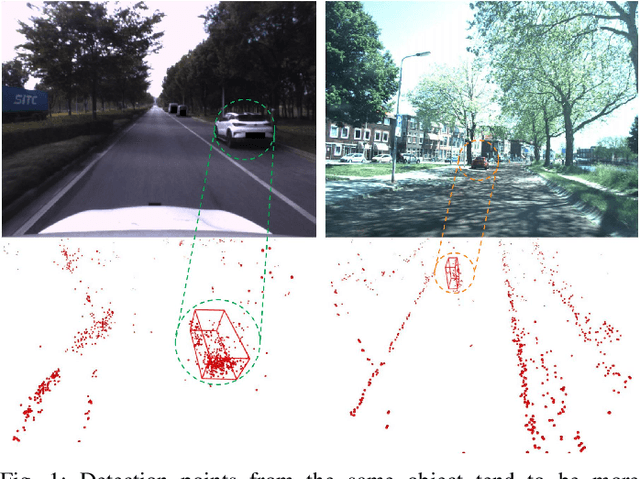
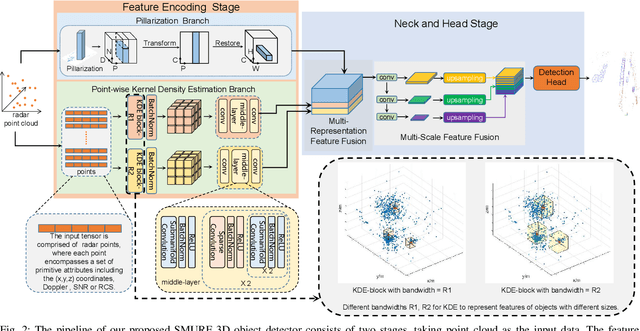

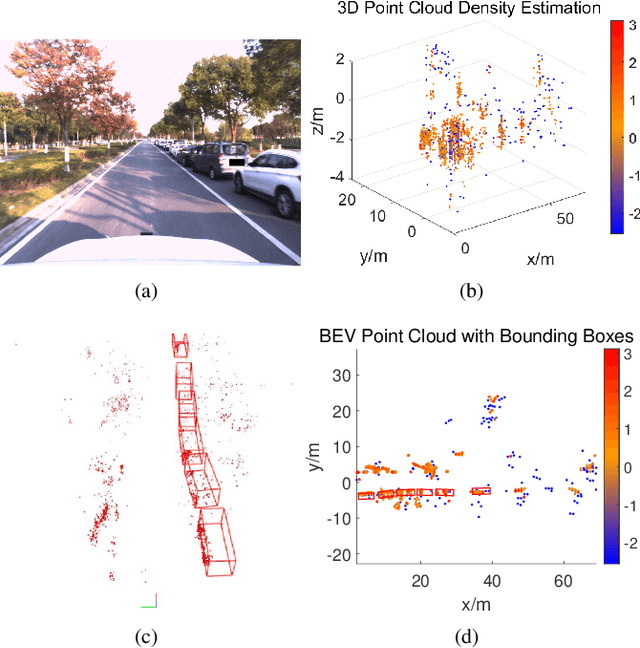
Abstract:The 4D Millimeter wave (mmWave) radar is a promising technology for vehicle sensing due to its cost-effectiveness and operability in adverse weather conditions. However, the adoption of this technology has been hindered by sparsity and noise issues in radar point cloud data. This paper introduces spatial multi-representation fusion (SMURF), a novel approach to 3D object detection using a single 4D imaging radar. SMURF leverages multiple representations of radar detection points, including pillarization and density features of a multi-dimensional Gaussian mixture distribution through kernel density estimation (KDE). KDE effectively mitigates measurement inaccuracy caused by limited angular resolution and multi-path propagation of radar signals. Additionally, KDE helps alleviate point cloud sparsity by capturing density features. Experimental evaluations on View-of-Delft (VoD) and TJ4DRadSet datasets demonstrate the effectiveness and generalization ability of SMURF, outperforming recently proposed 4D imaging radar-based single-representation models. Moreover, while using 4D imaging radar only, SMURF still achieves comparable performance to the state-of-the-art 4D imaging radar and camera fusion-based method, with an increase of 1.22% in the mean average precision on bird's-eye view of TJ4DRadSet dataset and 1.32% in the 3D mean average precision on the entire annotated area of VoD dataset. Our proposed method demonstrates impressive inference time and addresses the challenges of real-time detection, with the inference time no more than 0.05 seconds for most scans on both datasets. This research highlights the benefits of 4D mmWave radar and is a strong benchmark for subsequent works regarding 3D object detection with 4D imaging radar.
LXL: LiDAR Excluded Lean 3D Object Detection with 4D Imaging Radar and Camera Fusion
Jul 07, 2023



Abstract:As an emerging technology and a relatively affordable device, the 4D imaging radar has already been confirmed effective in performing 3D object detection in autonomous driving. Nevertheless, the sparsity and noisiness of 4D radar point clouds hinder further performance improvement, and in-depth studies about its fusion with other modalities are lacking. On the other hand, most of the camera-based perception methods transform the extracted image perspective view features into the bird's-eye view geometrically via "depth-based splatting" proposed in Lift-Splat-Shoot (LSS), and some researchers exploit other modals such as LiDARs or ordinary automotive radars for enhancement. Recently, a few works have applied the "sampling" strategy for image view transformation, showing that it outperforms "splatting" even without image depth prediction. However, the potential of "sampling" is not fully unleashed. In this paper, we investigate the "sampling" view transformation strategy on the camera and 4D imaging radar fusion-based 3D object detection. In the proposed model, LXL, predicted image depth distribution maps and radar 3D occupancy grids are utilized to aid image view transformation, called "radar occupancy-assisted depth-based sampling". Experiments on VoD and TJ4DRadSet datasets show that the proposed method outperforms existing 3D object detection methods by a significant margin without bells and whistles. Ablation studies demonstrate that our method performs the best among different enhancement settings.
Visual Semantic Segmentation Based on Few/Zero-Shot Learning: An Overview
Nov 13, 2022Abstract:Visual semantic segmentation aims at separating a visual sample into diverse blocks with specific semantic attributes and identifying the category for each block, and it plays a crucial role in environmental perception. Conventional learning-based visual semantic segmentation approaches count heavily on large-scale training data with dense annotations and consistently fail to estimate accurate semantic labels for unseen categories. This obstruction spurs a craze for studying visual semantic segmentation with the assistance of few/zero-shot learning. The emergence and rapid progress of few/zero-shot visual semantic segmentation make it possible to learn unseen-category from a few labeled or zero-labeled samples, which advances the extension to practical applications. Therefore, this paper focuses on the recently published few/zero-shot visual semantic segmentation methods varying from 2D to 3D space and explores the commonalities and discrepancies of technical settlements under different segmentation circumstances. Specifically, the preliminaries on few/zero-shot visual semantic segmentation, including the problem definitions, typical datasets, and technical remedies, are briefly reviewed and discussed. Moreover, three typical instantiations are involved to uncover the interactions of few/zero-shot learning with visual semantic segmentation, including image semantic segmentation, video object segmentation, and 3D segmentation. Finally, the future challenges of few/zero-shot visual semantic segmentation are discussed.
RaLiBEV: Radar and LiDAR BEV Fusion Learning for Anchor Box Free Object Detection System
Nov 11, 2022Abstract:Radar, the only sensor that could provide reliable perception capability in all weather conditions at an affordable cost, has been widely accepted as a key supplement to camera and LiDAR in modern advanced driver assistance systems (ADAS) and autonomous driving systems. Recent state-of-the-art works reveal that fusion of radar and LiDAR can lead to robust detection in adverse weather, such as fog. However, these methods still suffer from low accuracy of bounding box estimations. This paper proposes a bird's-eye view (BEV) fusion learning for an anchor box-free object detection system, which uses the feature derived from the radar range-azimuth heatmap and the LiDAR point cloud to estimate the possible objects. Different label assignment strategies have been designed to facilitate the consistency between the classification of foreground or background anchor points and the corresponding bounding box regressions. Furthermore, the performance of the proposed object detector can be further enhanced by employing a novel interactive transformer module. We demonstrated the superior performance of the proposed methods in this paper using the recently published Oxford Radar RobotCar (ORR) dataset. We showed that the accuracy of our system significantly outperforms the other state-of-the-art methods by a large margin.
Deep Learning-Based Autonomous Driving Systems: A Survey of Attacks and Defenses
Apr 10, 2021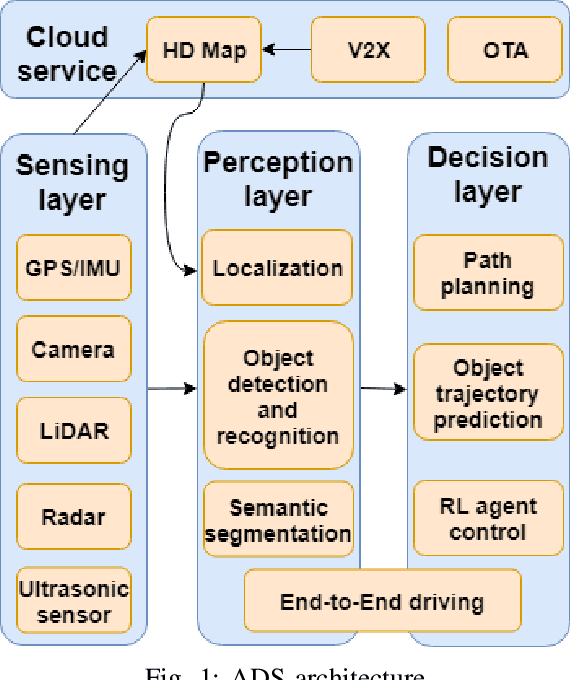

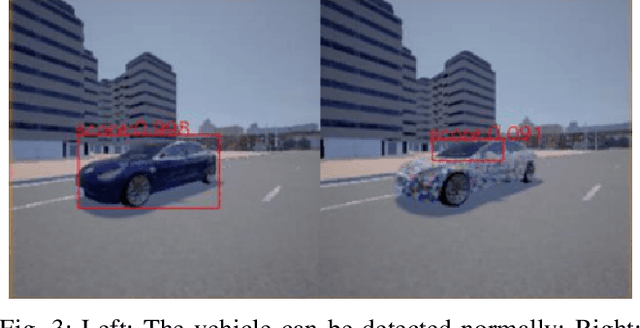
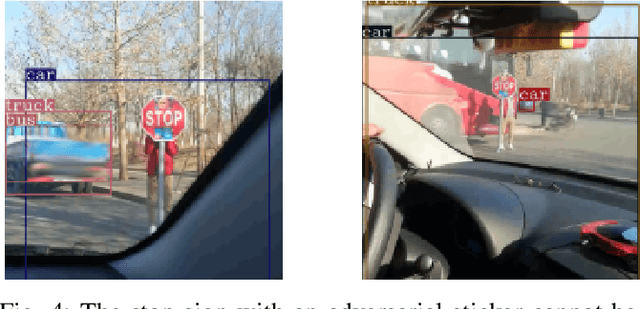
Abstract:The rapid development of artificial intelligence, especially deep learning technology, has advanced autonomous driving systems (ADSs) by providing precise control decisions to counterpart almost any driving event, spanning from anti-fatigue safe driving to intelligent route planning. However, ADSs are still plagued by increasing threats from different attacks, which could be categorized into physical attacks, cyberattacks and learning-based adversarial attacks. Inevitably, the safety and security of deep learning-based autonomous driving are severely challenged by these attacks, from which the countermeasures should be analyzed and studied comprehensively to mitigate all potential risks. This survey provides a thorough analysis of different attacks that may jeopardize ADSs, as well as the corresponding state-of-the-art defense mechanisms. The analysis is unrolled by taking an in-depth overview of each step in the ADS workflow, covering adversarial attacks for various deep learning models and attacks in both physical and cyber context. Furthermore, some promising research directions are suggested in order to improve deep learning-based autonomous driving safety, including model robustness training, model testing and verification, and anomaly detection based on cloud/edge servers.
Machine Learning Based Cyber Attacks Targeting on Controlled Information: A Survey
Feb 16, 2021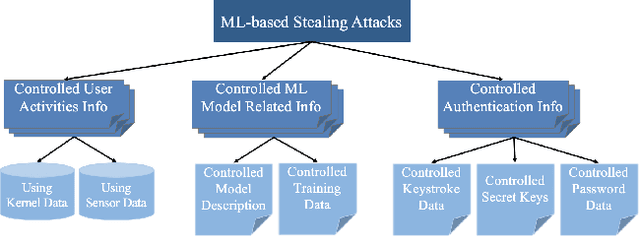

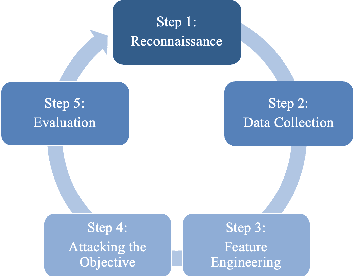
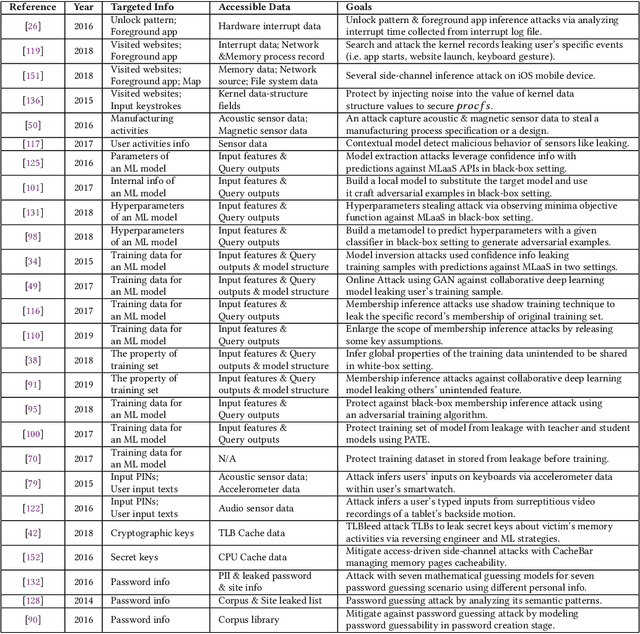
Abstract:Stealing attack against controlled information, along with the increasing number of information leakage incidents, has become an emerging cyber security threat in recent years. Due to the booming development and deployment of advanced analytics solutions, novel stealing attacks utilize machine learning (ML) algorithms to achieve high success rate and cause a lot of damage. Detecting and defending against such attacks is challenging and urgent so that governments, organizations, and individuals should attach great importance to the ML-based stealing attacks. This survey presents the recent advances in this new type of attack and corresponding countermeasures. The ML-based stealing attack is reviewed in perspectives of three categories of targeted controlled information, including controlled user activities, controlled ML model-related information, and controlled authentication information. Recent publications are summarized to generalize an overarching attack methodology and to derive the limitations and future directions of ML-based stealing attacks. Furthermore, countermeasures are proposed towards developing effective protections from three aspects -- detection, disruption, and isolation.
 Add to Chrome
Add to Chrome Add to Firefox
Add to Firefox Add to Edge
Add to Edge